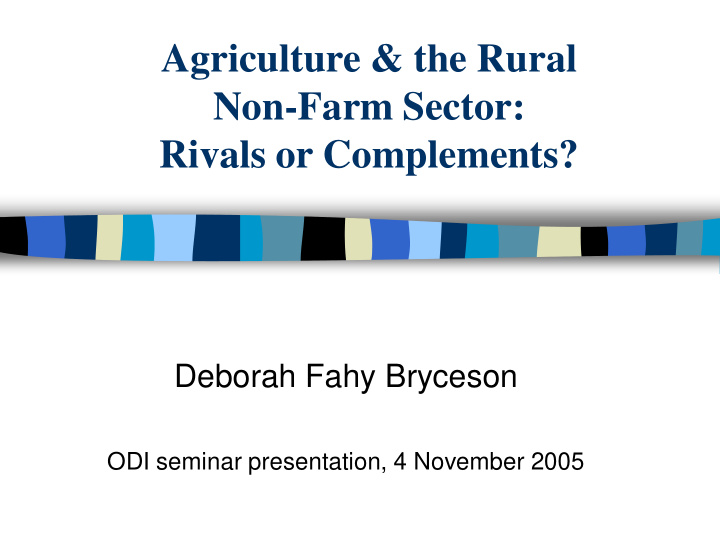



Agriculture & the Rural Non-Farm Sector: Rivals or Complements? Deborah Fahy Bryceson ODI seminar presentation, 4 November 2005
The Debate: agriculture vs. rural non-farm sectors What is at issue? – welfare – vested interests Disciplinary perspective? – Agricultural Economics – Rural Sociology – Human Geography Unit of analysis? – sector – farm production unit – family household production/consumption/cultural unit
African Peasants in Transition Peasant household characteristics: – FARM - subsistence & commodity production – FAMILY - unit of production – CLASS - position vis-à-vis state and global market – COMMUNITY - remote African smallholder peasant households – FARM - producing subsistence food & cashcrops – FAMILY • Male heads of households produced the cashcrop • Women produced the foodcrops for HH consumption • Children increasingly attended school – CLASS - Peasant-state/market relations worked during the late 1960s & 1970s as evidenced in Tanzanian peasant export production
State/Market Reorientation, 1980s Mid & Late 1970s Oil Crisis challenged the competitiveness of peasant export crops – parastatal marketing doomed Introduction of SAP – economic & political chain reaction leading to SAP – pricing seen as central incentive for raising export crop output – policies to replace state intervention with open markets – elimination of producer and social service subsidies
Peasant HH Restructuring, 1980s HH need for cash due to declining export crop production & subsidy removal Diversification of HH production – off-farm activities – non-agricultural activities – experimentation generating ‘winners’ & ‘losers’ Labour force expansion – entry of women and youth as cash earners Socio-political repercussions – economic autonomy of women and youth – declining coherence of household production units – increased economic differentiation in countryside
Economic Liberalization, 1990s Effect on peasant HH production – export crop production stagnant or declining per capita – geographical differentiation - location of HH vis-à-vis non-farm opportunities – growth of urban areas & non-agricultural activities as stimulus to agriculture (not classic industrialization model) Striking differences in country trajectories: Tanzania vs. Malawi
Tanzanian Depeasantization Path Rural income diversification very widespread Peasant income diversification has been supported by national economic diversification – mining – tourism – steady urbanization
Malawi Depeasantization Path Peasant income diversification thwarted by: – decline of male labourers’ remittances – lack of rural purchasing power – agricultural involution - high population density, low crop yields & reliance on mono-cropping – relatively low level of urbanization (13.5%) Outcome: rampant rural poverty and resort to casual wage labour market entwined in vicious cycle of famine and HIV infection
Current rural policies Economic liberalization/poverty alleviation – ambiguous policies pulling in opposing directions – poverty alleviation redresses SAP’s impact Economic liberalization – affirms households’ diversification process – arrests decline in peasant agricultural exports but not on a rural per capita basis Rural producers highly market responsive – thriving urban market for food production – some non-farm activities have profound welfare and rural lifestyle implications in the 21st century
Agriculture vs. Non-Farm - whose dilemma? Tanzania can no longer be considered a primarily agrarian country & Malawi is still agrarian but with dismal prospects Ag vs. Non-Farm - not an issue for rural diversifiers who do both – retention of a subsistence fallback – responsive to best economic returns on commercial production - ag or non-farm – seeking income on more individualized basis than before causing loss in rural peasant HH coherence – small-scale rural producers are now more flexible in Tanzania and more desperate in Malawi
Agriculture vs. Non-Farm - policy implications Defensiveness of agricultural specialists re. deagrarianization/depeasantization is misplaced – re-evaluate existing assumptions and models – need to come to grips with the producers, their changing production units, activities & lifestyles
Agriculture vs. Non-Farm - Real or Postulated Complementarity? Peasant agricultural export commodity prospects are extremely unpromising Nature of linkages between agriculture & non-farm within households changing Households retain a firm commitment to food self-provisioning National investment in commercial smallholder food production is vital
Recommend
More recommend